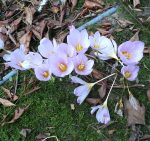 Native to parts of Turkey, Syria and Lebanon, this perennial corm is a member of the iris family, Iridaceae, that also includes gladiola, freesia, and crocosmia. Plants produce goblet-shaped pale lilac flowers with yellow throat and creamy-yellow stamens in autumn or early winter. The grass-like leaves appear after the flowers and remain to replenish the corm. The plants are rampant self-seeders which sometimes results in undersized flowers. Additionally, virus infected corms may produce undersized and deformed flowers. When well grown, these crocuses are attractive in beds, borders, and gravel, rock, and container gardens and add color when few other plants are blooming. The genus name, Crocus, is from the Greek word κρόκος, krokos meaning thread and refers to the appearance of the stigmas. The specific epithet, kotschyanus, honors Theodor Kotschy (1801-1887), Austrian botanist, plant-collector and traveller in North Africa and western Asia.
Native to parts of Turkey, Syria and Lebanon, this perennial corm is a member of the iris family, Iridaceae, that also includes gladiola, freesia, and crocosmia. Plants produce goblet-shaped pale lilac flowers with yellow throat and creamy-yellow stamens in autumn or early winter. The grass-like leaves appear after the flowers and remain to replenish the corm. The plants are rampant self-seeders which sometimes results in undersized flowers. Additionally, virus infected corms may produce undersized and deformed flowers. When well grown, these crocuses are attractive in beds, borders, and gravel, rock, and container gardens and add color when few other plants are blooming. The genus name, Crocus, is from the Greek word κρόκος, krokos meaning thread and refers to the appearance of the stigmas. The specific epithet, kotschyanus, honors Theodor Kotschy (1801-1887), Austrian botanist, plant-collector and traveller in North Africa and western Asia.
Type: Perennial corm
Bloom: Goblet-shaped, pale lilac flowers with yellow throat in autumn or early winter
Size: 4″ H
Light: Full sun, partial shade
Soil: Average-lean, medium moist, well-drained; tolerates some drought
Hardiness: Zones 6-9
Care: Low maintenance
Pests and Diseases: Generally healthy but susceptible to damage by mice, voles, and squirrels; viral infection can cause small deformed flowers.
Propagation: Seed, division
Companion Plants: Cyclamen, blue mist shrub, “Autumn Joy’ sedum
Photo Credit: Meneerke bloem Wikipedia